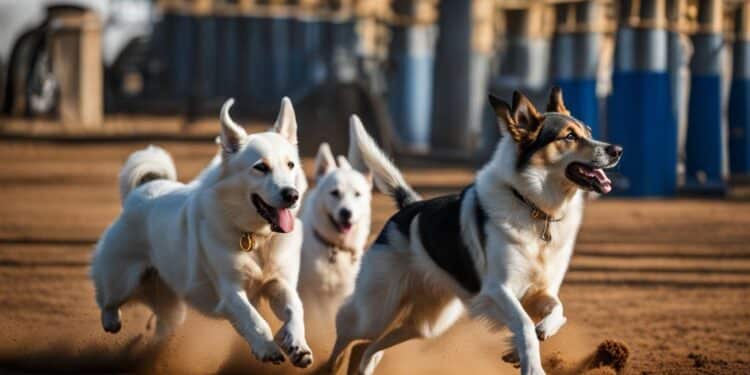Beyond Basics: Exploring Advanced Dog Training Techniques

Advanced Commands for Dog Training
When it comes to dog training, advanced commands are a game-changer. These commands go beyond the basics of “sit” and “stay,” allowing you to teach your furry friend more complex instructions. By incorporating advanced commands like “heel,” “fetch,” “find,” and “leave it,” you can take your dog’s training to the next level.
Teaching advanced commands requires a combination of patience, consistency, and positive reinforcement. It’s important to gradually introduce and reinforce each command, ensuring that your dog understands and can execute them successfully. By doing so, you expand your pet’s repertoire of skills and enhance your own training abilities.
By incorporating advanced commands into your dog’s training regimen, you not only stimulate their mind but also strengthen the bond between you and your furry companion. These commands give you greater control over your dog’s behavior and allow them to exhibit more advanced skills. Whether you’re looking to compete in dog sports or simply want a well-behaved pet, mastering advanced commands is a key step in achieving your goals.
The Benefits of Advanced Commands
- Enhanced communication: Advanced commands improve the communication between you and your dog, allowing for clearer instructions and a deeper understanding.
- Mental stimulation: Learning advanced commands challenges your dog’s mind and provides mental stimulation, preventing boredom and promoting overall well-being.
- Greater control: Advanced commands give you greater control over your dog’s behavior, allowing them to respond to cues even in distracting environments.
- Expanded skillset: By teaching advanced commands, you expand your dog’s skillset, enabling them to participate in various activities such as agility, obedience, and scent work.
By incorporating advanced commands into your dog’s training routine, you set the stage for a well-trained, well-rounded canine companion. With consistent practice, positive reinforcement, and a dash of patience, your dog will master these commands and become an obedient and impressive partner.
| Command | Description |
|---|---|
| Heel | The dog walks closely beside the handler’s left leg without pulling or lagging behind. |
| Fetch | The dog retrieves and brings back an object, such as a ball or a toy, to the handler. |
| Find | The dog uses its scenting abilities to locate and signal the presence of a specific object or person. |
| Leave it | The dog is trained to resist the temptation of an object or food item and leave it untouched. |
Off-Leash Training: Taking Training to the Next Level
Off-leash training is an essential aspect of advanced dog training that allows dogs to develop increased freedom while still obeying commands and exhibiting good behavior. By removing the constraint of a leash, dogs can explore their surroundings with a greater sense of engagement and independence. However, it is crucial to establish a solid foundation in basic obedience commands before attempting off-leash training.
Off-leash training involves gradually transitioning from on-leash to off-leash control, ensuring that the dog is reliable and responsive to commands even without the physical restraint of a leash. This process requires patience, consistency, and positive reinforcement to reinforce desired behaviors. It is recommended to practice off-leash training in a controlled environment, such as a securely fenced yard or a designated off-leash area, before progressing to public spaces.
To ensure safety during off-leash training, it is important to employ certain precautions. A dog should have a strong recall command, allowing them to reliably return to their owner when called. Additionally, it is advisable to carry treats or use a reward system to motivate and reward the dog for their good behavior. Using visual or audible cues, such as a whistle or hand signal, can also help reinforce commands and maintain control during off-leash training sessions.
Benefits of Off-Leash Training
Off-leash training offers numerous benefits for both dogs and their owners. It strengthens the bond between the dog and owner, as the dog learns to trust and rely on their human companion even without physical restraint. It also promotes mental stimulation and physical exercise, allowing dogs to explore and interact with their environment more freely.
Moreover, off-leash training opens up opportunities for dogs to participate in various canine sports, such as agility, obedience trials, and scent work. These activities provide mental and physical challenges, further enhancing the dog’s training and overall well-being.
| Benefits of Off-Leash Training | Additional Information |
|---|---|
| Increased freedom and engagement | Dogs can explore their surroundings with a greater sense of independence. |
| Enhanced bond with the owner | Dogs learn to trust and rely on their human companions even without physical restraint. |
| Mental stimulation and physical exercise | Dogs can explore and interact with their environment more freely, promoting overall well-being. |
| Opportunities for canine sports | Dogs can participate in activities such as agility, obedience trials, and scent work. |
By incorporating off-leash training into their dog’s advanced training regimen, owners can unlock their pet’s true potential, enhance communication, and create a well-rounded and obedient companion.
Concluding Thoughts on Advanced Dog Training Methods
Mastering advanced dog training methods not only enhances basic obedience but opens a gateway to a world of opportunities for both dogs and their owners. One of the significant advantages of advanced training is enabling dogs to participate in various canine sports, such as agility, obedience, and scent work.
Engaging in canine sports not only provides physical exercise but also strengthens the bond between dogs and their owners. These activities foster teamwork, communication, and trust while promoting mental stimulation for dogs. With advanced training methods, dogs can excel in these sports, showcasing their intelligence, agility, and natural abilities.
Advanced dog training methods also aim to tap into a dog’s true potential. By delving into advanced commands, off-leash training, and other advanced techniques, owners can unlock their pet’s hidden talents. Dogs thrive on mental challenges, and advanced training provides the opportunity to keep their minds sharp and active.
Furthermore, participating in canine sports and advanced training methods can provide a sense of accomplishment for both owners and dogs. Witnessing their pet’s progress and achievements brings immense satisfaction and pride, creating a strong and lasting bond between dog and owner.
FAQ
What are advanced commands in dog training?
Advanced commands are complex instructions that go beyond the basic “sit” and “stay” and include commands such as “heel,” “fetch,” “find,” and “leave it.”
What does it take to teach dogs advanced commands?
Teaching dogs advanced commands requires patience, consistency, and positive reinforcement. Gradually introducing and reinforcing these commands can expand a dog’s repertoire of skills and enhance their training abilities.
How important is off-leash training?
Off-leash training is integral to advanced dog training. It allows dogs to roam freely without a leash while still following commands and exhibiting good behavior.
What is required for successful off-leash training?
Off-leash training requires a strong foundation in basic obedience commands and a gradual transition to off-leash control. Employing safety precautions and ensuring a dog’s reliability is essential before practicing off-leash training in public areas.
What are the benefits of mastering advanced dog training methods?
Mastering advanced dog training methods opens up possibilities for dogs to participate in various canine sports such as agility, obedience, and scent work. It strengthens the bond between dogs and their owners, enhances communication, and promotes mental stimulation for dogs.






